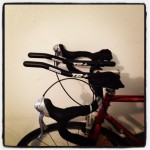 Aero Bars for beginners
Aero Bars for beginners
With my foot being messed up this summer I’m riding a lot. Last winter when I thought seriously about doing an IronMan this summer I started to collect all the expensive knick knacks that manifest with the tyranny of triathlon.
I was under pressure to buy a new bike. Among all the other thousands of dollars of equipment and training, triathletes love their bikes. Most triathletes have at least two, possibly three bicycles.
There are bicycles especially designed for triathlons. These are called tri-bikes. The big difference between tri-bikes and regular bikes is drafting. You are not allowed to draft in a triathlon. This means that you cannot ride in a pack like they do in the Tour de France.
There is a reason the pro cyclist ride in a pack. There is a reason that the peleton always catches the breakaway riders. That is the simple reason that it is much more efficient to ride in a tightly packed group. The group creates an envelope in the air flow that makes everyone faster.
In a triathlon you can’t do that. As a result the tri bikes are built to be as aerodynamic as possible. They do this in a couple ways. One is that they smooth out the surfaces to prevent drag. For instance you’ll notice the disc wheels and all the components are broad and oblong to promote efficient airflow.
The other way tri-bikes promote aerodynamics is to position the rider in the “Aero” position. In the aero position the rider hunches way over and rests on his or her elbows with the forearms and hands close together like the tip of a spear.
Tearing myself away from the path of unnecessary financial destruction from the triathlon addiction I decided to, instead of buying a new bike, get some aero-bars for my old Fuji.
Aero-bars allow you to approximate the ‘aero position’ on your standard road bike. They are two pipes that jut out from the front center of your handlebars. They clip on either side of the gooseneck. They have elbow pads so that you can ‘assume the position’ with your elbows seated on the cross bar and your forearms and hands pointed forward.
I bought a set of clip on aero bars called T2 by Profile Design. It took me a few adjustments to get the position right. The bars are adjustable in separation and angle of elevation. The elbow seats are adjustable in 2 dimensions as well. In order to get the position correct you’ll have to adjust your seat up and forward a bit.
It’s not perfect but it’s a good approximation.
How do they work? They certainly take some getting used to. Once you have the adjustments dialed in you’ll need to practice riding in the position. It is a bit unstable to move your control surfaces so close to the center of the bike steering wheel and your center of gravity so far forward. You’ll want to start out on an open road, or bike trail or even your trainer to get used to the position because there is much less control and initially plenty of swerving and erratic riding.
I asked the coach why triathletes would ride in such an unstable position. He said that most tri courses are closed to traffic, are relatively flat and straight. You could never ride aero-bars in a group ride – you’d kill someone.
Most serious triathletes move the brakes out onto the aero-bars. With the clip-ons I’m basically riding without brakes when I’m in the aero position. You have to get good at transitioning out of the aero and getting your hands back on the control surfaces and the brakes if you’re going to be riding in traffic.
They also are not designed for hill climbing per se. When I get up out of the saddle my knees will bump the elbow pads a bit.
When you are in the aero position you aren’t steering the bike with your hands. Your hands are out in front on the unstable bars. You don’t grip the bars. To the contrary, you un-weight and un-grip the bars. You are steering with your body weight. The hands simply guide a bit. In the unstable position you cannot overreact. It takes a light touch. Your weight is on the elbow pads and your hands are just along for the ride.
You have to get to the point where you have very good form without too much side-to-side torque. You have to focus on pedaling with just your legs. You have to focus on pulling the power evenly and pushing over the top of the pedals. The instability forces you to ride cleanly.
Once you get used to it, it is quite comfortable. It is best suited for long, flat, straight stretches without too many hills. The rail trail is perfect. When the wind kicks up it does help you glide through the buffeting a bit slicker.
In summary; aero bars may not be for everyone but if you plan on doing a lot of long solo rides you may want to invest in some clip-ons. Once you get used to it it’s very comfortable and efficient.
